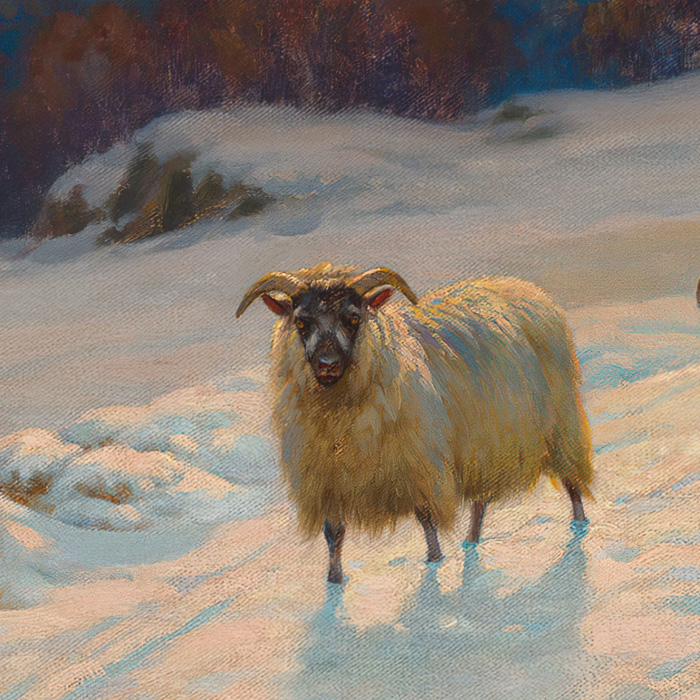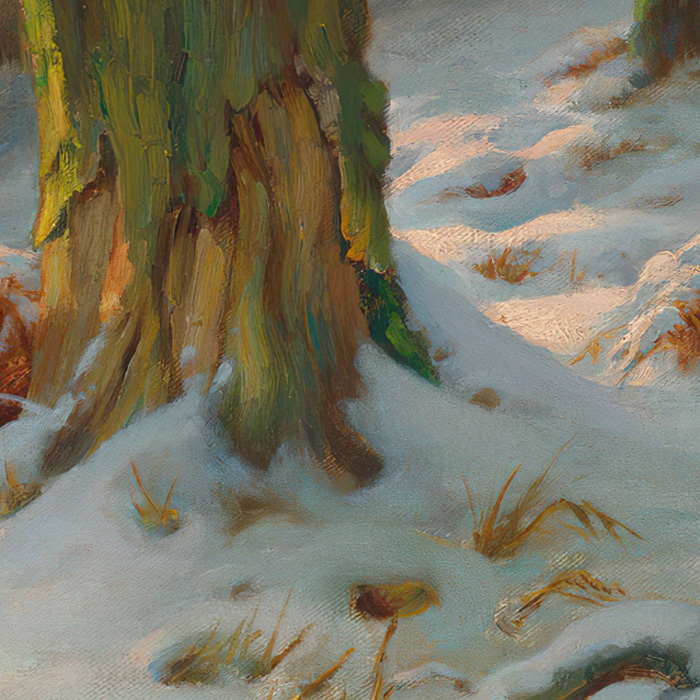

Contrasts
of Winter
Mr. Hadden Turner

As the bitter north winds begin to blow and the day yields its golden hours to the night, the trees surrender the last of the leaves, which have clung on throughout the autumn. Beyond the confines of the now barren woodlands, on lawns and meadows alike, the ground becomes hard and firm with frosts glistening in the glow of the morning sunlight, a tell-tale sign that temperatures have plummeted. And as they fall and the first flakes of snow appear, the hearths of the dwellings near and far become ever warmer and ever brighter. Winter, with all its harsh hardships and spectacular beauty, has arrived.
Winter can indeed be spectacularly beautiful. Waking up to glistening hoar frosts delicately coating every tree, surveying landscapes blanketed in unblemished snow, these are the memories winter evokes — and are the scenes displayed prominently on our Christmas cards. However, down in the sunny south of England, these days of beauty are the exception, not the norm. Some winters pass without a single “snow day” and daytime temperatures rarely remain below freezing; one must awake early to enjoy the beauty of the frosts. This is in sharp contrast to the northern reaches of the country. Up there, where the latitudes and altitudes are higher, regular dustings of snow beautify the landscape, along with the occasional severe snowstorm. But when it does snow down south (and more importantly, settle), the delight of local children is a joy to witness. Snowballs fly through the air and snowmen are erected like winter scarecrows in every field and park, each one a unique and diversely dressed monument of childhood bliss.
But alhough there is delight in abundance out in the playgrounds and on the streets, for many winter may be a time of dreaded hardship, especially for those who are old or isolated. It is a painful fact that both hospitals and undertakers are at their busiest in the winter, as cold temperatures, icy walkways, and biting winds take their toll on older bodies and immune systems. Part of being a good neighbor in wintertime is checking in regularly on older people who live nearby and inviting them over from time to time for a cup of tea or a convivial meal by the fire. Similarly, for those older people among us, being a good neighbor can mean sharing wisdom and stories of this season with the young and inexperienced.
For those who live and work in the great outdoors, too, winter has its difficulties in store. Up in the north of England, snow is a frequent occurrence.  When the wind howls and the blizzards descend, snow can accumulate into deadly snow drifts. These natural phenomena are a menace for the shepherd and his flock and demand his constant vigilance. Stray, lone sheep can easily succumb to the ravages of this season, each one a bitter loss to the shepherd, who feels an immense sense of responsibility whenever a creature under his care perishes.
When the wind howls and the blizzards descend, snow can accumulate into deadly snow drifts. These natural phenomena are a menace for the shepherd and his flock and demand his constant vigilance. Stray, lone sheep can easily succumb to the ravages of this season, each one a bitter loss to the shepherd, who feels an immense sense of responsibility whenever a creature under his care perishes.
The trials the shepherd and farmer coupled with the hardships endured by elders and the poor remind us of a vital lesson that this season of contrasts teaches us: the joys of some are sorrows for others. Snow is loved by children and detested by shepherds. Frosts and ice are strikingly beautiful but can be a deadly hazard. There are as many different ways to experience and interpret winter as there are persons to interpret it. Part of the lesson of the season is to remember that when we are rejoicing, we must take care not to overlook others who may be struggling.

The trials the shepherd and farmer coupled with the hardships endured by elders and the poor remind us of a vital lesson that this season of contrasts teaches us: the joys of some are sorrows for others.

Wonderfully, though winter can be a time of immense hardship, it can also be a time of much needed rest. This is certainly the case for my garden. By now, all work has ceased. My plants have been harvested, their dead and decaying stems are in the process of being converted again into rich soil, and the best seeds have been saved and sorted. I have experimented with trying to grow some crops over the winter but with little success. Perhaps this is my garden’s way of telling me to let it be. I, like many other gardeners, pay heed to these signs and leave the garden and its soil to fallow during the long winter months — and leave the earthworms to do their work of decomposition undisturbed in the soil.
Now that my soil is being taken care of, I can turn my attention to the trees and dense foliage surrounding my garden to try and see some of the delightful creatures hidden within. Winter is the best time to see some of my favorite bird species: redwing, fieldfare, and goldcrest, and if I am fortunate, even a flock of waxwing may appear, gorging themselves on the remainder of the rowan berries that festoon the trees behind our garden. Out on the estuaries for which Essex is famous, huge flocks of brent geese fly in off the coast, and a distant peregrine may be found patrolling above the inlets and creeks in search of his prey. Birdwatching during winter is the best form of rest for me. Few things make me happier than getting up at dawn to walk over the desolate salt-marshes to see the birds, whether alone with my thoughts or in pleasant company.
Apart from the birds and mammals, which need to stay active during winter in order to feed, the woods and meadows are stiller now that creatures great and small have entered into their own prolonged periods of rest. Some hibernate while others substantially slow down their rate of activity, entering into what is called the state of torpor. Hedgehogs and lizards no longer scurry through the undergrowth, bats huddle together and refrain from flying out at night, and most insects have died, leaving their eggs and larvae safe in the earth or in cracks and crevices, awaiting the warmth of spring. Nature changes its rhythm and pace to match the tempo and limitations of the season. The natural world slows down in winter — perhaps we should too.
 Rest is something we struggle with in this modern always-switched-on world. We appear to be ever active and ever working. Busyness is considered a virtue, and our industries and politicians reinforce this with their endless pleas for greater productivity. The accolades and bonuses they lavish on those who work overtime or meet moving targets clearly showcase where their affections, values, and desires lie. In such an atmosphere, we can easily forget our fundamental need for rest. This is only exacerbated now that our lives and jobs are no longer substantially tied to the cycles and rhythms of the land and weather, nor greatly affected by their limitations.
Rest is something we struggle with in this modern always-switched-on world. We appear to be ever active and ever working. Busyness is considered a virtue, and our industries and politicians reinforce this with their endless pleas for greater productivity. The accolades and bonuses they lavish on those who work overtime or meet moving targets clearly showcase where their affections, values, and desires lie. In such an atmosphere, we can easily forget our fundamental need for rest. This is only exacerbated now that our lives and jobs are no longer substantially tied to the cycles and rhythms of the land and weather, nor greatly affected by their limitations.
But we are created beings, designed with fundamental limitations that are an integral part of our humanity. We have been created for rest as well as work. It is why we spend at least a third of our lives asleep. Our unalterable need for rest is our ultimate limitation. But our limits are in fact ordered toward our flourishing. We know we work best after a good night’s sleep; we know how refreshing it feels to take a break after strenuous labor; and we all know how pleasurable worthy recreations are. Limitations are for our good —they are part of our Maker’s design, and rest is part of his instructions for our lives. When he became incarnate as a man, Jesus the Creator dignified rest every time he slept. Even a stormy sea did not stop him from this most vital of tasks.

Limitations are for our good —they are part of our Maker’s design, and rest is part of his instructions for our lives. When he became incarnate as a man, Jesus the Creator dignified rest every time he slept.

Winter, especially for those who work outside, reminds us of our need for rest by presenting challenges that force us to slow down or stop. The ground is hard and frosty, unconducive to the plough or shovel, and a heavy snowfall may force us to take a “snow day” off. Some tasks must wait for better weather, and work generally takes on a slower pace. Certainly, this was the case for our ancestors who lacked heavy machine power to plough through the snow or dig through the frosty earth. The limitations the weather imposed made them take a prolonged rest, whether they wanted to or not. Perhaps this was a blessing in disguise for bodies that bore the brunt of at times grueling manual farm and outdoor labor.
Though we now have the technologies, tools, and machines available to mitigate many of the limitations winter imposes, perhaps it is wise to reflect on the necessity for rest and accept — or even embrace — where we can the limitations that the season brings. Instead of striving to remove all inconvenience and hardship there is both wisdom and joy to be had in reintegrating our lives with the rhythms and limitations of the seasons. Perhaps, rather than working hard to clear the snow off the driveway, we might take a day out of our normal working routine and spend a snow day at home or play outside with children and friends. Or perhaps we could occasionally see the early arrival of evening darkness as a sign to put down tools rather than turning the lights on to continue our work. Of course, many, perhaps even most of us, do not have the liberty or permission to slow our pace of work more than a little during wintertime, nor can we all take extra days off. Still, the season might remind us of our need to take an extended period of rest when we can, even if at a different time of the year, and not to neglect this fundamental need.
Rest does not mean sitting and doing nothing, though often it includes that. Feasting and fun — activities that refresh and reinvigorate — also can be construed as rest. Perhaps this is one of the reasons why winter is traditionally full of festivals, feasts, and parties. Work for most of us is put on hold whilst we celebrate Christmas and the breaking of the New Year, for example. In the past, these festivals full of light provided a joyful relief from the long dark nights and bitterly cold days. They were something that could be eagerly awaited and a needed encouragement to endure the present hardships. Though we may not endure the same degree of hardships now, come the first snow or cold snap we still anticipate the arrival of wintertime celebrations with the same vigor and delight. In my neighborhood the best comfort of wintertime is the proliferation of warmth and light that emanates from candles in the local church and twinkling lights on the highstreet. From hot punch with its warm spicy aroma to the crackling fire in my living room, light and warmth bring abounding joy and deep rest in this season. Indeed, “The Light shines in the darkness, and the darkness has not overcome it.”
After the feasting and celebrations of December and January, work returns to the fields and towns, as February soon arrives. Though often a dreary, gray, and dull month, far from the feastings and festivities of early winter, February is not without its reminders of the coming abundance of new life and the hope that longer days will soon again triumph over the dark winter nights. The first green shoots of snowdrops, crocuses, and daffodils push their way through the late winter frosts — messengers from deep under the earth heralding the coming change. Catkins adorn the bare branches of the hazel and the birch, and I may even catch sight of a passing brimstone butterfly, whose sulphurous wings are easily seen against the gray and brown backdrop of a late winter wood. I like to call these butterflies “spring-heralds,” as they remind me that in a few weeks’ time, all will be change. Spring, with all its warmth and abundance of new life, will return.


